Business Operations and Services: Toyota's Improvement Strategies
VerifiedAdded on 2021/02/19
|11
|3872
|32
Report
AI Summary
This report delves into the realm of business operations and service, focusing on the strategies employed by Toyota Motor Corporation. It begins with an overview of Toyota, highlighting its position in the automotive industry and its key competitors like Ford and General Motors. The main body of the report explores operations improvement strategies, including process and continuous improvement strategies. It details the Lean Process Model, including its five principles, and the Six Sigma Model (DMAIC approach). Furthermore, it discusses the 5S Strategy Model and the Total Quality Management Model, including the PDCA cycle. The report also introduces tools and techniques like 5 Why Analysis, Ishikawa diagrams, and Pareto charts. The report also presents the operational strategies of Ford and General Motors in gaining market share from Toyota. Ultimately, the report provides a comprehensive analysis of Toyota's operational strategies and the tools and techniques used for continuous improvement, offering valuable insights into the company's success in the automotive industry.
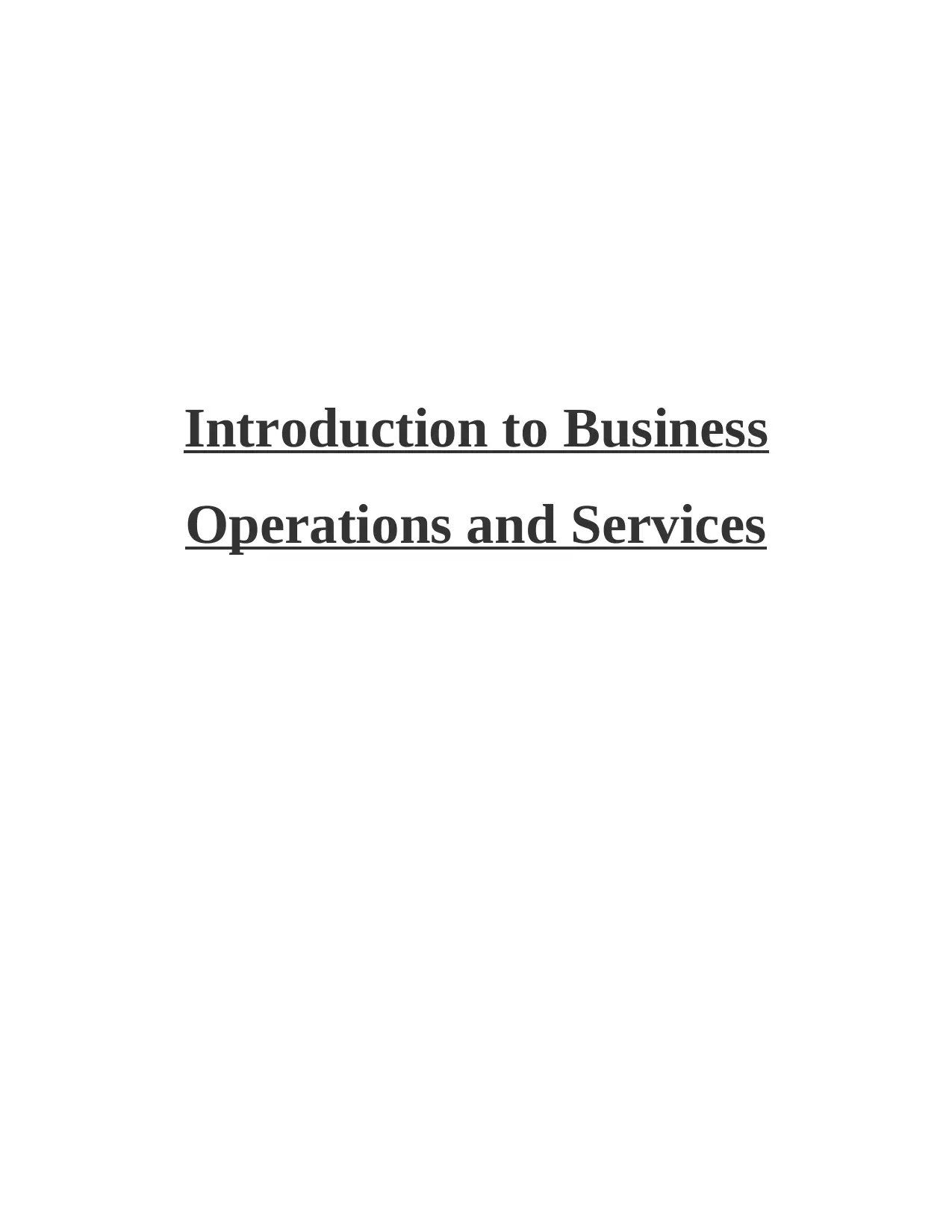
Introduction to Business
Operations and Services
Operations and Services
Paraphrase This Document
Need a fresh take? Get an instant paraphrase of this document with our AI Paraphraser
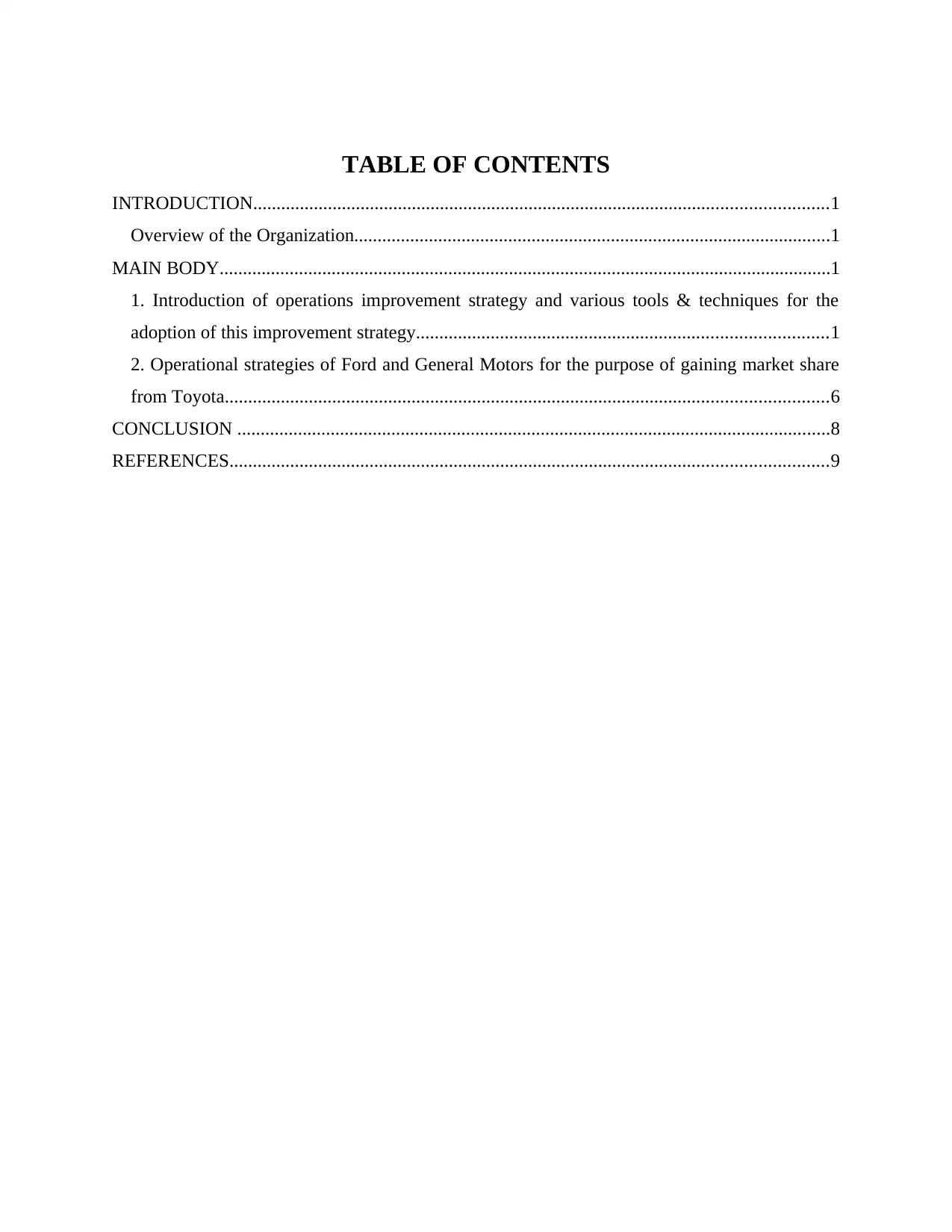
TABLE OF CONTENTS
INTRODUCTION...........................................................................................................................1
Overview of the Organization......................................................................................................1
MAIN BODY...................................................................................................................................1
1. Introduction of operations improvement strategy and various tools & techniques for the
adoption of this improvement strategy........................................................................................1
2. Operational strategies of Ford and General Motors for the purpose of gaining market share
from Toyota.................................................................................................................................6
CONCLUSION ...............................................................................................................................8
REFERENCES................................................................................................................................9
INTRODUCTION...........................................................................................................................1
Overview of the Organization......................................................................................................1
MAIN BODY...................................................................................................................................1
1. Introduction of operations improvement strategy and various tools & techniques for the
adoption of this improvement strategy........................................................................................1
2. Operational strategies of Ford and General Motors for the purpose of gaining market share
from Toyota.................................................................................................................................6
CONCLUSION ...............................................................................................................................8
REFERENCES................................................................................................................................9
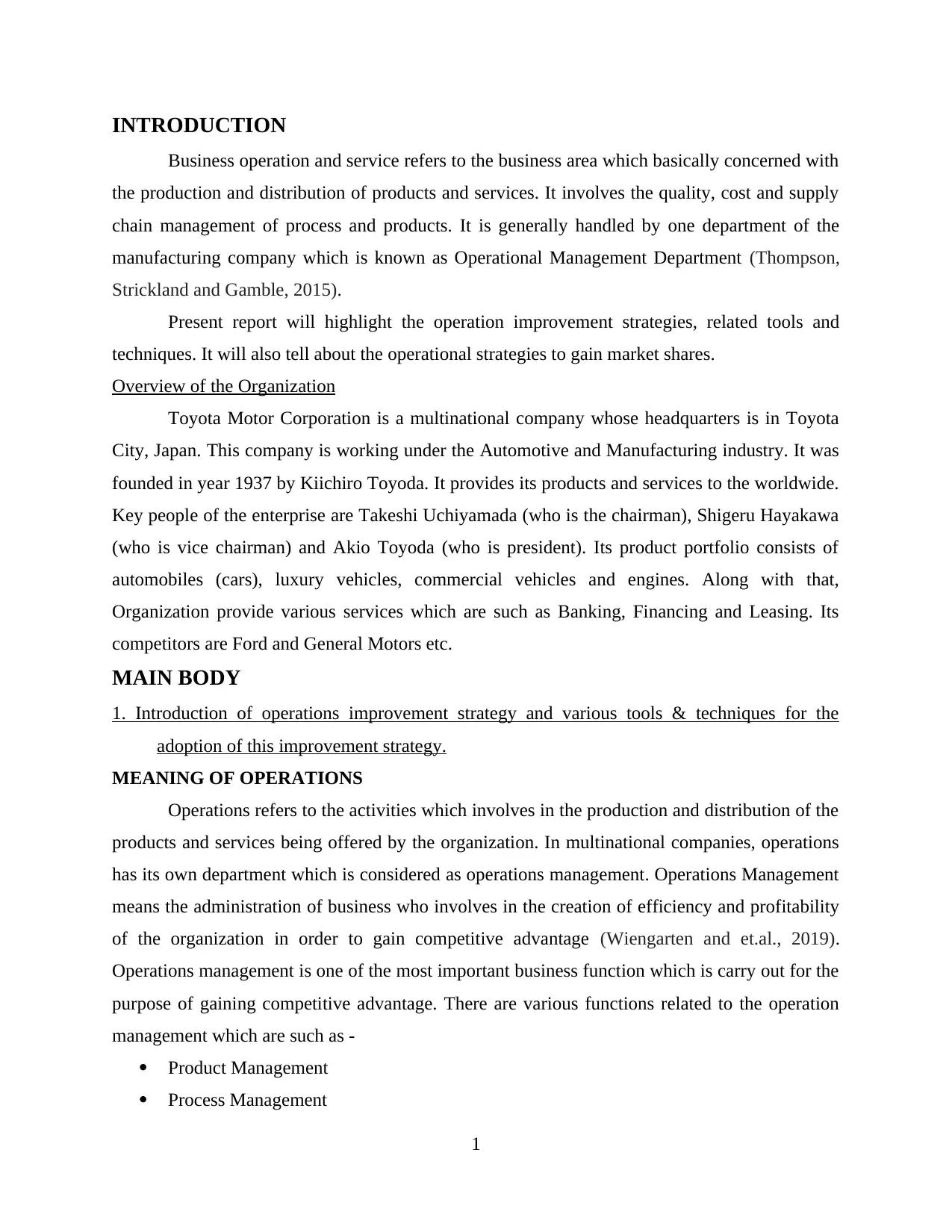
INTRODUCTION
Business operation and service refers to the business area which basically concerned with
the production and distribution of products and services. It involves the quality, cost and supply
chain management of process and products. It is generally handled by one department of the
manufacturing company which is known as Operational Management Department (Thompson,
Strickland and Gamble, 2015).
Present report will highlight the operation improvement strategies, related tools and
techniques. It will also tell about the operational strategies to gain market shares.
Overview of the Organization
Toyota Motor Corporation is a multinational company whose headquarters is in Toyota
City, Japan. This company is working under the Automotive and Manufacturing industry. It was
founded in year 1937 by Kiichiro Toyoda. It provides its products and services to the worldwide.
Key people of the enterprise are Takeshi Uchiyamada (who is the chairman), Shigeru Hayakawa
(who is vice chairman) and Akio Toyoda (who is president). Its product portfolio consists of
automobiles (cars), luxury vehicles, commercial vehicles and engines. Along with that,
Organization provide various services which are such as Banking, Financing and Leasing. Its
competitors are Ford and General Motors etc.
MAIN BODY
1. Introduction of operations improvement strategy and various tools & techniques for the
adoption of this improvement strategy.
MEANING OF OPERATIONS
Operations refers to the activities which involves in the production and distribution of the
products and services being offered by the organization. In multinational companies, operations
has its own department which is considered as operations management. Operations Management
means the administration of business who involves in the creation of efficiency and profitability
of the organization in order to gain competitive advantage (Wiengarten and et.al., 2019).
Operations management is one of the most important business function which is carry out for the
purpose of gaining competitive advantage. There are various functions related to the operation
management which are such as -
Product Management
Process Management
1
Business operation and service refers to the business area which basically concerned with
the production and distribution of products and services. It involves the quality, cost and supply
chain management of process and products. It is generally handled by one department of the
manufacturing company which is known as Operational Management Department (Thompson,
Strickland and Gamble, 2015).
Present report will highlight the operation improvement strategies, related tools and
techniques. It will also tell about the operational strategies to gain market shares.
Overview of the Organization
Toyota Motor Corporation is a multinational company whose headquarters is in Toyota
City, Japan. This company is working under the Automotive and Manufacturing industry. It was
founded in year 1937 by Kiichiro Toyoda. It provides its products and services to the worldwide.
Key people of the enterprise are Takeshi Uchiyamada (who is the chairman), Shigeru Hayakawa
(who is vice chairman) and Akio Toyoda (who is president). Its product portfolio consists of
automobiles (cars), luxury vehicles, commercial vehicles and engines. Along with that,
Organization provide various services which are such as Banking, Financing and Leasing. Its
competitors are Ford and General Motors etc.
MAIN BODY
1. Introduction of operations improvement strategy and various tools & techniques for the
adoption of this improvement strategy.
MEANING OF OPERATIONS
Operations refers to the activities which involves in the production and distribution of the
products and services being offered by the organization. In multinational companies, operations
has its own department which is considered as operations management. Operations Management
means the administration of business who involves in the creation of efficiency and profitability
of the organization in order to gain competitive advantage (Wiengarten and et.al., 2019).
Operations management is one of the most important business function which is carry out for the
purpose of gaining competitive advantage. There are various functions related to the operation
management which are such as -
Product Management
Process Management
1
⊘ This is a preview!⊘
Do you want full access?
Subscribe today to unlock all pages.

Trusted by 1+ million students worldwide
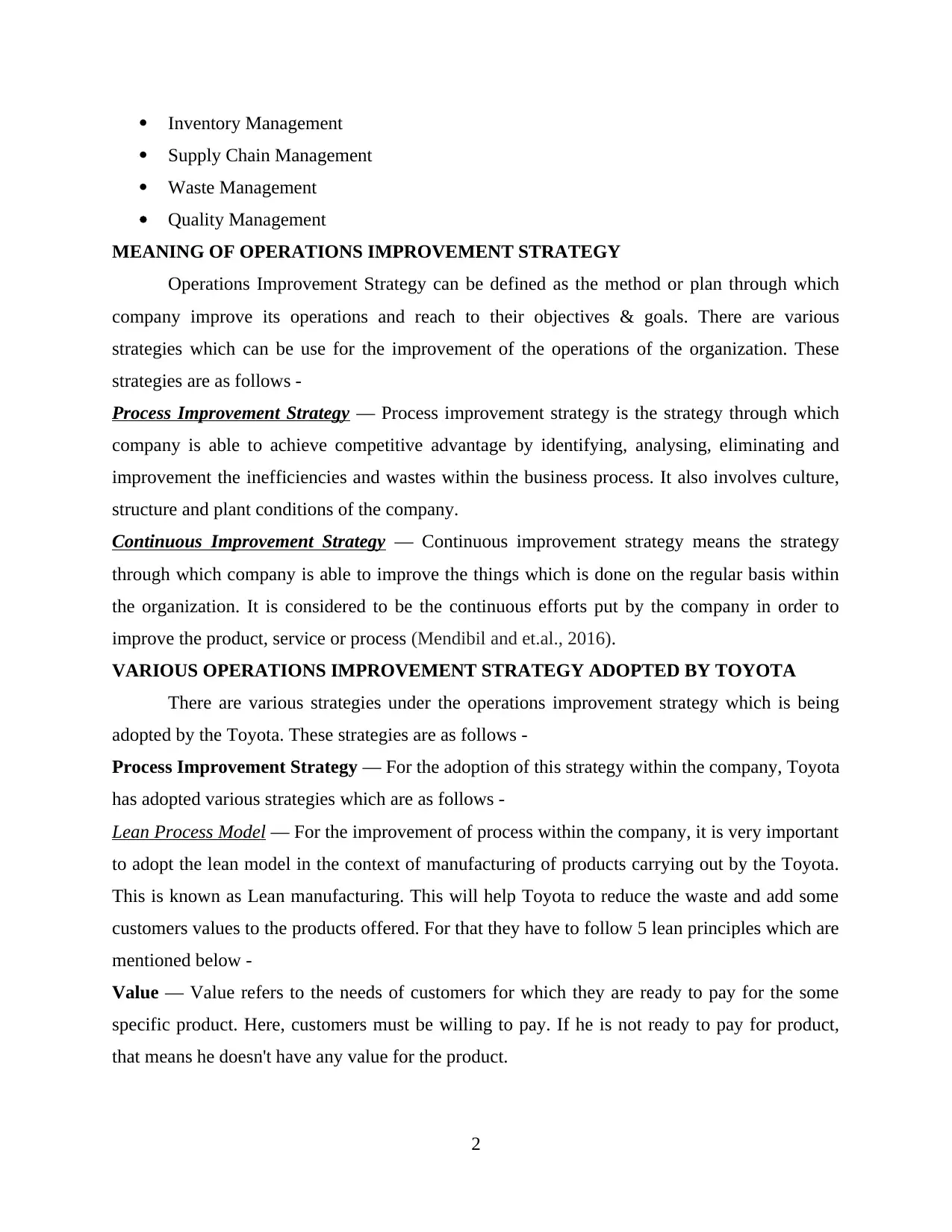
Inventory Management
Supply Chain Management
Waste Management
Quality Management
MEANING OF OPERATIONS IMPROVEMENT STRATEGY
Operations Improvement Strategy can be defined as the method or plan through which
company improve its operations and reach to their objectives & goals. There are various
strategies which can be use for the improvement of the operations of the organization. These
strategies are as follows -
Process Improvement Strategy — Process improvement strategy is the strategy through which
company is able to achieve competitive advantage by identifying, analysing, eliminating and
improvement the inefficiencies and wastes within the business process. It also involves culture,
structure and plant conditions of the company.
Continuous Improvement Strategy — Continuous improvement strategy means the strategy
through which company is able to improve the things which is done on the regular basis within
the organization. It is considered to be the continuous efforts put by the company in order to
improve the product, service or process (Mendibil and et.al., 2016).
VARIOUS OPERATIONS IMPROVEMENT STRATEGY ADOPTED BY TOYOTA
There are various strategies under the operations improvement strategy which is being
adopted by the Toyota. These strategies are as follows -
Process Improvement Strategy — For the adoption of this strategy within the company, Toyota
has adopted various strategies which are as follows -
Lean Process Model — For the improvement of process within the company, it is very important
to adopt the lean model in the context of manufacturing of products carrying out by the Toyota.
This is known as Lean manufacturing. This will help Toyota to reduce the waste and add some
customers values to the products offered. For that they have to follow 5 lean principles which are
mentioned below -
Value — Value refers to the needs of customers for which they are ready to pay for the some
specific product. Here, customers must be willing to pay. If he is not ready to pay for product,
that means he doesn't have any value for the product.
2
Supply Chain Management
Waste Management
Quality Management
MEANING OF OPERATIONS IMPROVEMENT STRATEGY
Operations Improvement Strategy can be defined as the method or plan through which
company improve its operations and reach to their objectives & goals. There are various
strategies which can be use for the improvement of the operations of the organization. These
strategies are as follows -
Process Improvement Strategy — Process improvement strategy is the strategy through which
company is able to achieve competitive advantage by identifying, analysing, eliminating and
improvement the inefficiencies and wastes within the business process. It also involves culture,
structure and plant conditions of the company.
Continuous Improvement Strategy — Continuous improvement strategy means the strategy
through which company is able to improve the things which is done on the regular basis within
the organization. It is considered to be the continuous efforts put by the company in order to
improve the product, service or process (Mendibil and et.al., 2016).
VARIOUS OPERATIONS IMPROVEMENT STRATEGY ADOPTED BY TOYOTA
There are various strategies under the operations improvement strategy which is being
adopted by the Toyota. These strategies are as follows -
Process Improvement Strategy — For the adoption of this strategy within the company, Toyota
has adopted various strategies which are as follows -
Lean Process Model — For the improvement of process within the company, it is very important
to adopt the lean model in the context of manufacturing of products carrying out by the Toyota.
This is known as Lean manufacturing. This will help Toyota to reduce the waste and add some
customers values to the products offered. For that they have to follow 5 lean principles which are
mentioned below -
Value — Value refers to the needs of customers for which they are ready to pay for the some
specific product. Here, customers must be willing to pay. If he is not ready to pay for product,
that means he doesn't have any value for the product.
2
Paraphrase This Document
Need a fresh take? Get an instant paraphrase of this document with our AI Paraphraser
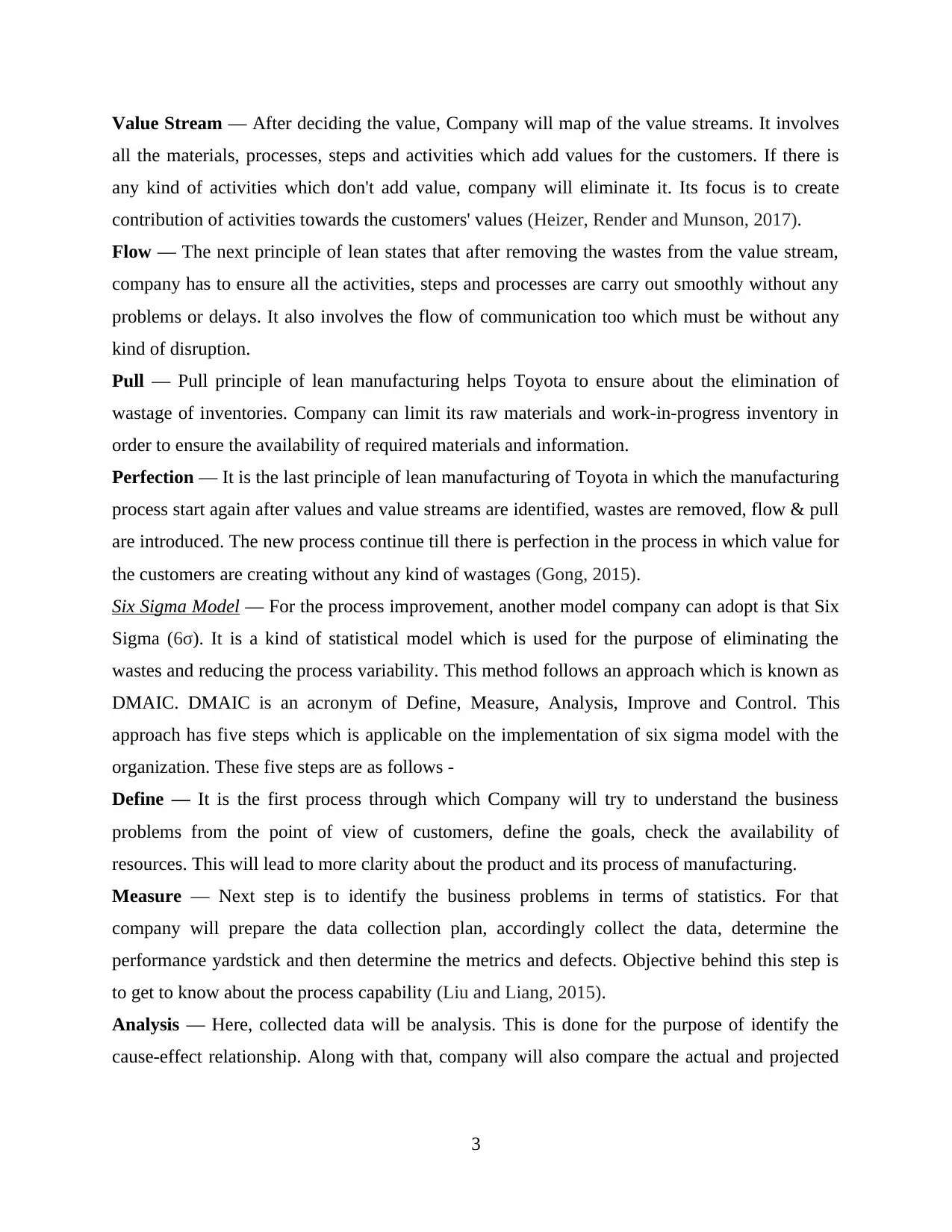
Value Stream — After deciding the value, Company will map of the value streams. It involves
all the materials, processes, steps and activities which add values for the customers. If there is
any kind of activities which don't add value, company will eliminate it. Its focus is to create
contribution of activities towards the customers' values (Heizer, Render and Munson, 2017).
Flow — The next principle of lean states that after removing the wastes from the value stream,
company has to ensure all the activities, steps and processes are carry out smoothly without any
problems or delays. It also involves the flow of communication too which must be without any
kind of disruption.
Pull — Pull principle of lean manufacturing helps Toyota to ensure about the elimination of
wastage of inventories. Company can limit its raw materials and work-in-progress inventory in
order to ensure the availability of required materials and information.
Perfection — It is the last principle of lean manufacturing of Toyota in which the manufacturing
process start again after values and value streams are identified, wastes are removed, flow & pull
are introduced. The new process continue till there is perfection in the process in which value for
the customers are creating without any kind of wastages (Gong, 2015).
Six Sigma Model — For the process improvement, another model company can adopt is that Six
Sigma (6σ). It is a kind of statistical model which is used for the purpose of eliminating the
wastes and reducing the process variability. This method follows an approach which is known as
DMAIC. DMAIC is an acronym of Define, Measure, Analysis, Improve and Control. This
approach has five steps which is applicable on the implementation of six sigma model with the
organization. These five steps are as follows -
Define — It is the first process through which Company will try to understand the business
problems from the point of view of customers, define the goals, check the availability of
resources. This will lead to more clarity about the product and its process of manufacturing.
Measure — Next step is to identify the business problems in terms of statistics. For that
company will prepare the data collection plan, accordingly collect the data, determine the
performance yardstick and then determine the metrics and defects. Objective behind this step is
to get to know about the process capability (Liu and Liang, 2015).
Analysis — Here, collected data will be analysis. This is done for the purpose of identify the
cause-effect relationship. Along with that, company will also compare the actual and projected
3
all the materials, processes, steps and activities which add values for the customers. If there is
any kind of activities which don't add value, company will eliminate it. Its focus is to create
contribution of activities towards the customers' values (Heizer, Render and Munson, 2017).
Flow — The next principle of lean states that after removing the wastes from the value stream,
company has to ensure all the activities, steps and processes are carry out smoothly without any
problems or delays. It also involves the flow of communication too which must be without any
kind of disruption.
Pull — Pull principle of lean manufacturing helps Toyota to ensure about the elimination of
wastage of inventories. Company can limit its raw materials and work-in-progress inventory in
order to ensure the availability of required materials and information.
Perfection — It is the last principle of lean manufacturing of Toyota in which the manufacturing
process start again after values and value streams are identified, wastes are removed, flow & pull
are introduced. The new process continue till there is perfection in the process in which value for
the customers are creating without any kind of wastages (Gong, 2015).
Six Sigma Model — For the process improvement, another model company can adopt is that Six
Sigma (6σ). It is a kind of statistical model which is used for the purpose of eliminating the
wastes and reducing the process variability. This method follows an approach which is known as
DMAIC. DMAIC is an acronym of Define, Measure, Analysis, Improve and Control. This
approach has five steps which is applicable on the implementation of six sigma model with the
organization. These five steps are as follows -
Define — It is the first process through which Company will try to understand the business
problems from the point of view of customers, define the goals, check the availability of
resources. This will lead to more clarity about the product and its process of manufacturing.
Measure — Next step is to identify the business problems in terms of statistics. For that
company will prepare the data collection plan, accordingly collect the data, determine the
performance yardstick and then determine the metrics and defects. Objective behind this step is
to get to know about the process capability (Liu and Liang, 2015).
Analysis — Here, collected data will be analysis. This is done for the purpose of identify the
cause-effect relationship. Along with that, company will also compare the actual and projected
3
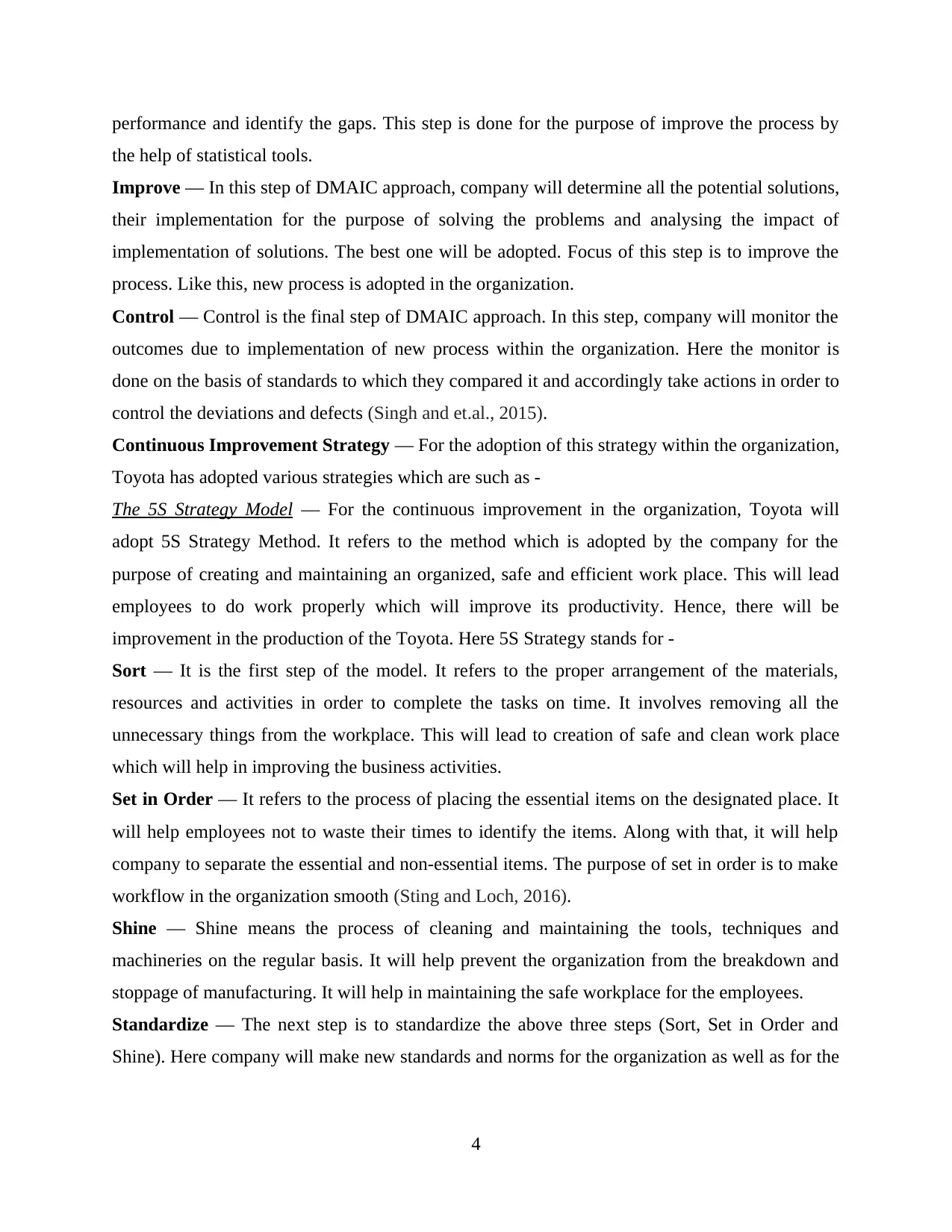
performance and identify the gaps. This step is done for the purpose of improve the process by
the help of statistical tools.
Improve — In this step of DMAIC approach, company will determine all the potential solutions,
their implementation for the purpose of solving the problems and analysing the impact of
implementation of solutions. The best one will be adopted. Focus of this step is to improve the
process. Like this, new process is adopted in the organization.
Control — Control is the final step of DMAIC approach. In this step, company will monitor the
outcomes due to implementation of new process within the organization. Here the monitor is
done on the basis of standards to which they compared it and accordingly take actions in order to
control the deviations and defects (Singh and et.al., 2015).
Continuous Improvement Strategy — For the adoption of this strategy within the organization,
Toyota has adopted various strategies which are such as -
The 5S Strategy Model — For the continuous improvement in the organization, Toyota will
adopt 5S Strategy Method. It refers to the method which is adopted by the company for the
purpose of creating and maintaining an organized, safe and efficient work place. This will lead
employees to do work properly which will improve its productivity. Hence, there will be
improvement in the production of the Toyota. Here 5S Strategy stands for -
Sort — It is the first step of the model. It refers to the proper arrangement of the materials,
resources and activities in order to complete the tasks on time. It involves removing all the
unnecessary things from the workplace. This will lead to creation of safe and clean work place
which will help in improving the business activities.
Set in Order — It refers to the process of placing the essential items on the designated place. It
will help employees not to waste their times to identify the items. Along with that, it will help
company to separate the essential and non-essential items. The purpose of set in order is to make
workflow in the organization smooth (Sting and Loch, 2016).
Shine — Shine means the process of cleaning and maintaining the tools, techniques and
machineries on the regular basis. It will help prevent the organization from the breakdown and
stoppage of manufacturing. It will help in maintaining the safe workplace for the employees.
Standardize — The next step is to standardize the above three steps (Sort, Set in Order and
Shine). Here company will make new standards and norms for the organization as well as for the
4
the help of statistical tools.
Improve — In this step of DMAIC approach, company will determine all the potential solutions,
their implementation for the purpose of solving the problems and analysing the impact of
implementation of solutions. The best one will be adopted. Focus of this step is to improve the
process. Like this, new process is adopted in the organization.
Control — Control is the final step of DMAIC approach. In this step, company will monitor the
outcomes due to implementation of new process within the organization. Here the monitor is
done on the basis of standards to which they compared it and accordingly take actions in order to
control the deviations and defects (Singh and et.al., 2015).
Continuous Improvement Strategy — For the adoption of this strategy within the organization,
Toyota has adopted various strategies which are such as -
The 5S Strategy Model — For the continuous improvement in the organization, Toyota will
adopt 5S Strategy Method. It refers to the method which is adopted by the company for the
purpose of creating and maintaining an organized, safe and efficient work place. This will lead
employees to do work properly which will improve its productivity. Hence, there will be
improvement in the production of the Toyota. Here 5S Strategy stands for -
Sort — It is the first step of the model. It refers to the proper arrangement of the materials,
resources and activities in order to complete the tasks on time. It involves removing all the
unnecessary things from the workplace. This will lead to creation of safe and clean work place
which will help in improving the business activities.
Set in Order — It refers to the process of placing the essential items on the designated place. It
will help employees not to waste their times to identify the items. Along with that, it will help
company to separate the essential and non-essential items. The purpose of set in order is to make
workflow in the organization smooth (Sting and Loch, 2016).
Shine — Shine means the process of cleaning and maintaining the tools, techniques and
machineries on the regular basis. It will help prevent the organization from the breakdown and
stoppage of manufacturing. It will help in maintaining the safe workplace for the employees.
Standardize — The next step is to standardize the above three steps (Sort, Set in Order and
Shine). Here company will make new standards and norms for the organization as well as for the
4
⊘ This is a preview!⊘
Do you want full access?
Subscribe today to unlock all pages.

Trusted by 1+ million students worldwide
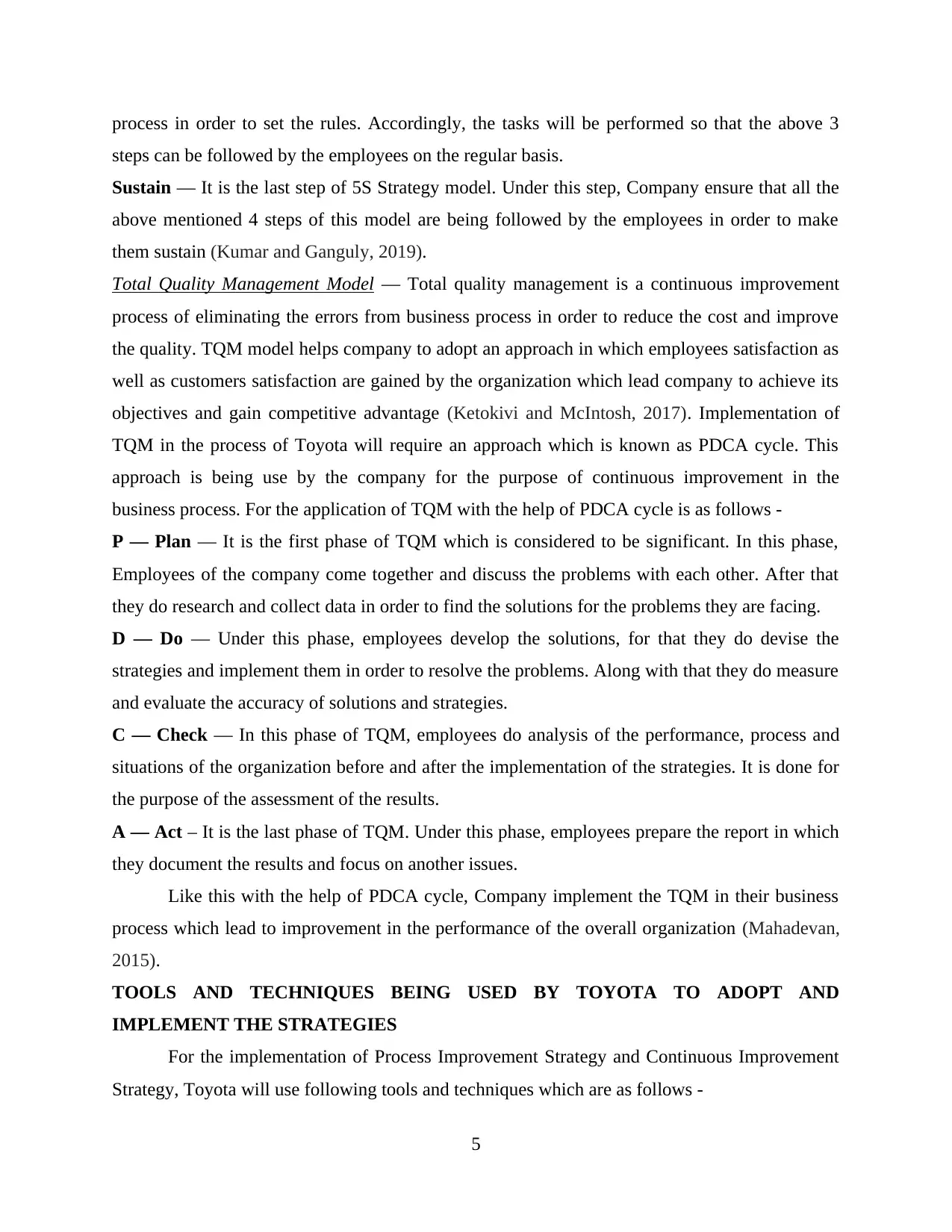
process in order to set the rules. Accordingly, the tasks will be performed so that the above 3
steps can be followed by the employees on the regular basis.
Sustain — It is the last step of 5S Strategy model. Under this step, Company ensure that all the
above mentioned 4 steps of this model are being followed by the employees in order to make
them sustain (Kumar and Ganguly, 2019).
Total Quality Management Model — Total quality management is a continuous improvement
process of eliminating the errors from business process in order to reduce the cost and improve
the quality. TQM model helps company to adopt an approach in which employees satisfaction as
well as customers satisfaction are gained by the organization which lead company to achieve its
objectives and gain competitive advantage (Ketokivi and McIntosh, 2017). Implementation of
TQM in the process of Toyota will require an approach which is known as PDCA cycle. This
approach is being use by the company for the purpose of continuous improvement in the
business process. For the application of TQM with the help of PDCA cycle is as follows -
P — Plan — It is the first phase of TQM which is considered to be significant. In this phase,
Employees of the company come together and discuss the problems with each other. After that
they do research and collect data in order to find the solutions for the problems they are facing.
D — Do — Under this phase, employees develop the solutions, for that they do devise the
strategies and implement them in order to resolve the problems. Along with that they do measure
and evaluate the accuracy of solutions and strategies.
C — Check — In this phase of TQM, employees do analysis of the performance, process and
situations of the organization before and after the implementation of the strategies. It is done for
the purpose of the assessment of the results.
A — Act – It is the last phase of TQM. Under this phase, employees prepare the report in which
they document the results and focus on another issues.
Like this with the help of PDCA cycle, Company implement the TQM in their business
process which lead to improvement in the performance of the overall organization (Mahadevan,
2015).
TOOLS AND TECHNIQUES BEING USED BY TOYOTA TO ADOPT AND
IMPLEMENT THE STRATEGIES
For the implementation of Process Improvement Strategy and Continuous Improvement
Strategy, Toyota will use following tools and techniques which are as follows -
5
steps can be followed by the employees on the regular basis.
Sustain — It is the last step of 5S Strategy model. Under this step, Company ensure that all the
above mentioned 4 steps of this model are being followed by the employees in order to make
them sustain (Kumar and Ganguly, 2019).
Total Quality Management Model — Total quality management is a continuous improvement
process of eliminating the errors from business process in order to reduce the cost and improve
the quality. TQM model helps company to adopt an approach in which employees satisfaction as
well as customers satisfaction are gained by the organization which lead company to achieve its
objectives and gain competitive advantage (Ketokivi and McIntosh, 2017). Implementation of
TQM in the process of Toyota will require an approach which is known as PDCA cycle. This
approach is being use by the company for the purpose of continuous improvement in the
business process. For the application of TQM with the help of PDCA cycle is as follows -
P — Plan — It is the first phase of TQM which is considered to be significant. In this phase,
Employees of the company come together and discuss the problems with each other. After that
they do research and collect data in order to find the solutions for the problems they are facing.
D — Do — Under this phase, employees develop the solutions, for that they do devise the
strategies and implement them in order to resolve the problems. Along with that they do measure
and evaluate the accuracy of solutions and strategies.
C — Check — In this phase of TQM, employees do analysis of the performance, process and
situations of the organization before and after the implementation of the strategies. It is done for
the purpose of the assessment of the results.
A — Act – It is the last phase of TQM. Under this phase, employees prepare the report in which
they document the results and focus on another issues.
Like this with the help of PDCA cycle, Company implement the TQM in their business
process which lead to improvement in the performance of the overall organization (Mahadevan,
2015).
TOOLS AND TECHNIQUES BEING USED BY TOYOTA TO ADOPT AND
IMPLEMENT THE STRATEGIES
For the implementation of Process Improvement Strategy and Continuous Improvement
Strategy, Toyota will use following tools and techniques which are as follows -
5
Paraphrase This Document
Need a fresh take? Get an instant paraphrase of this document with our AI Paraphraser
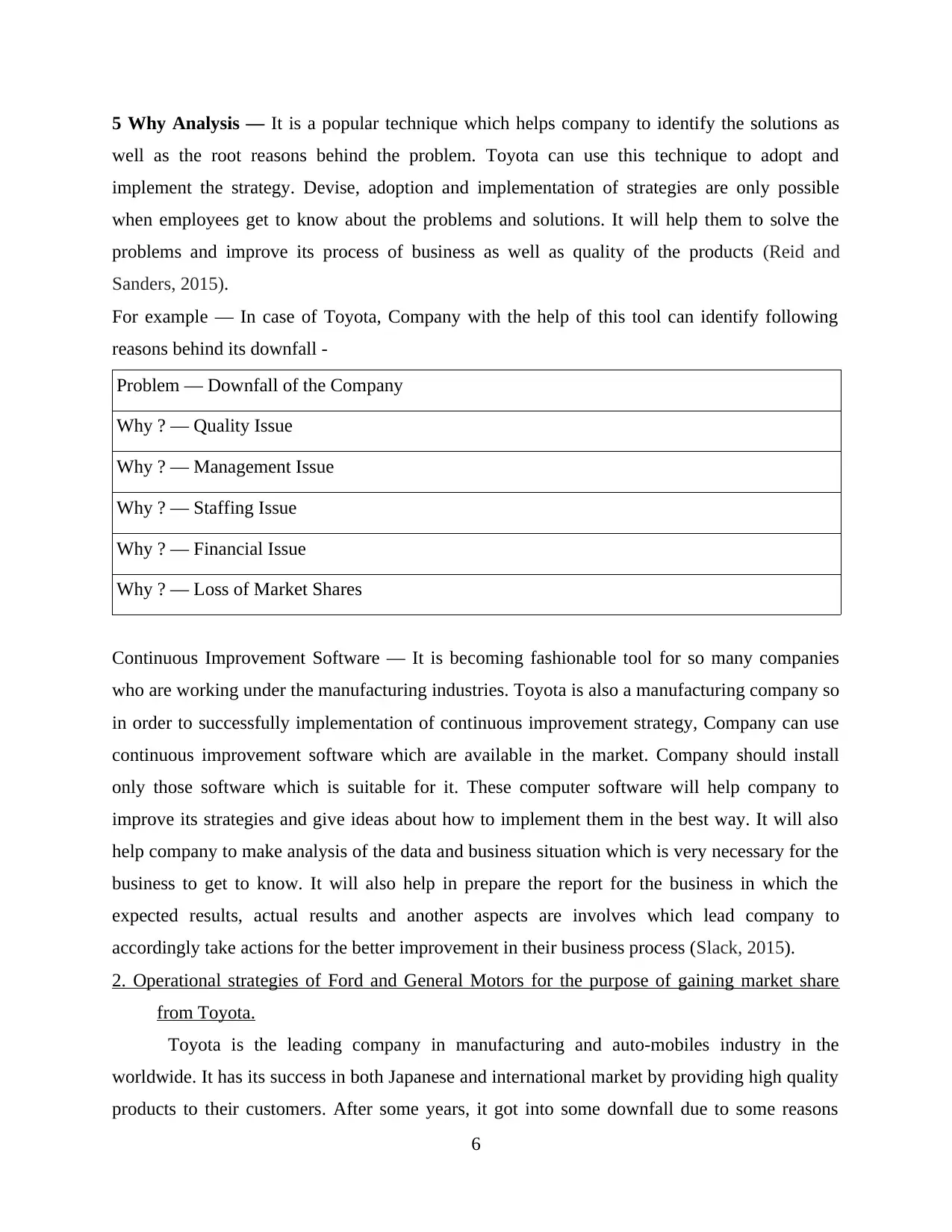
5 Why Analysis — It is a popular technique which helps company to identify the solutions as
well as the root reasons behind the problem. Toyota can use this technique to adopt and
implement the strategy. Devise, adoption and implementation of strategies are only possible
when employees get to know about the problems and solutions. It will help them to solve the
problems and improve its process of business as well as quality of the products (Reid and
Sanders, 2015).
For example — In case of Toyota, Company with the help of this tool can identify following
reasons behind its downfall -
Problem — Downfall of the Company
Why ? — Quality Issue
Why ? — Management Issue
Why ? — Staffing Issue
Why ? — Financial Issue
Why ? — Loss of Market Shares
Continuous Improvement Software — It is becoming fashionable tool for so many companies
who are working under the manufacturing industries. Toyota is also a manufacturing company so
in order to successfully implementation of continuous improvement strategy, Company can use
continuous improvement software which are available in the market. Company should install
only those software which is suitable for it. These computer software will help company to
improve its strategies and give ideas about how to implement them in the best way. It will also
help company to make analysis of the data and business situation which is very necessary for the
business to get to know. It will also help in prepare the report for the business in which the
expected results, actual results and another aspects are involves which lead company to
accordingly take actions for the better improvement in their business process (Slack, 2015).
2. Operational strategies of Ford and General Motors for the purpose of gaining market share
from Toyota.
Toyota is the leading company in manufacturing and auto-mobiles industry in the
worldwide. It has its success in both Japanese and international market by providing high quality
products to their customers. After some years, it got into some downfall due to some reasons
6
well as the root reasons behind the problem. Toyota can use this technique to adopt and
implement the strategy. Devise, adoption and implementation of strategies are only possible
when employees get to know about the problems and solutions. It will help them to solve the
problems and improve its process of business as well as quality of the products (Reid and
Sanders, 2015).
For example — In case of Toyota, Company with the help of this tool can identify following
reasons behind its downfall -
Problem — Downfall of the Company
Why ? — Quality Issue
Why ? — Management Issue
Why ? — Staffing Issue
Why ? — Financial Issue
Why ? — Loss of Market Shares
Continuous Improvement Software — It is becoming fashionable tool for so many companies
who are working under the manufacturing industries. Toyota is also a manufacturing company so
in order to successfully implementation of continuous improvement strategy, Company can use
continuous improvement software which are available in the market. Company should install
only those software which is suitable for it. These computer software will help company to
improve its strategies and give ideas about how to implement them in the best way. It will also
help company to make analysis of the data and business situation which is very necessary for the
business to get to know. It will also help in prepare the report for the business in which the
expected results, actual results and another aspects are involves which lead company to
accordingly take actions for the better improvement in their business process (Slack, 2015).
2. Operational strategies of Ford and General Motors for the purpose of gaining market share
from Toyota.
Toyota is the leading company in manufacturing and auto-mobiles industry in the
worldwide. It has its success in both Japanese and international market by providing high quality
products to their customers. After some years, it got into some downfall due to some reasons
6
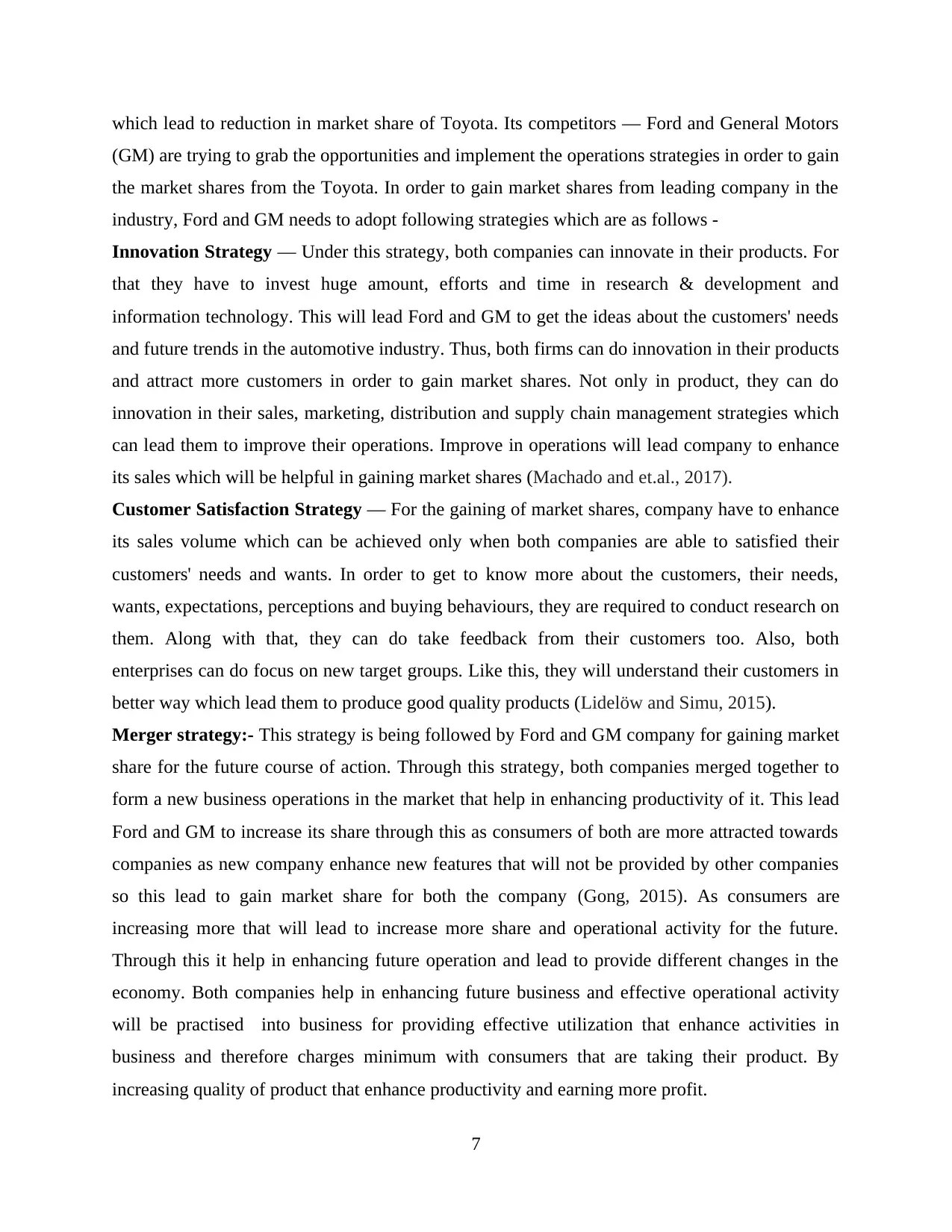
which lead to reduction in market share of Toyota. Its competitors — Ford and General Motors
(GM) are trying to grab the opportunities and implement the operations strategies in order to gain
the market shares from the Toyota. In order to gain market shares from leading company in the
industry, Ford and GM needs to adopt following strategies which are as follows -
Innovation Strategy — Under this strategy, both companies can innovate in their products. For
that they have to invest huge amount, efforts and time in research & development and
information technology. This will lead Ford and GM to get the ideas about the customers' needs
and future trends in the automotive industry. Thus, both firms can do innovation in their products
and attract more customers in order to gain market shares. Not only in product, they can do
innovation in their sales, marketing, distribution and supply chain management strategies which
can lead them to improve their operations. Improve in operations will lead company to enhance
its sales which will be helpful in gaining market shares (Machado and et.al., 2017).
Customer Satisfaction Strategy — For the gaining of market shares, company have to enhance
its sales volume which can be achieved only when both companies are able to satisfied their
customers' needs and wants. In order to get to know more about the customers, their needs,
wants, expectations, perceptions and buying behaviours, they are required to conduct research on
them. Along with that, they can do take feedback from their customers too. Also, both
enterprises can do focus on new target groups. Like this, they will understand their customers in
better way which lead them to produce good quality products (Lidelöw and Simu, 2015).
Merger strategy:- This strategy is being followed by Ford and GM company for gaining market
share for the future course of action. Through this strategy, both companies merged together to
form a new business operations in the market that help in enhancing productivity of it. This lead
Ford and GM to increase its share through this as consumers of both are more attracted towards
companies as new company enhance new features that will not be provided by other companies
so this lead to gain market share for both the company (Gong, 2015). As consumers are
increasing more that will lead to increase more share and operational activity for the future.
Through this it help in enhancing future operation and lead to provide different changes in the
economy. Both companies help in enhancing future business and effective operational activity
will be practised into business for providing effective utilization that enhance activities in
business and therefore charges minimum with consumers that are taking their product. By
increasing quality of product that enhance productivity and earning more profit.
7
(GM) are trying to grab the opportunities and implement the operations strategies in order to gain
the market shares from the Toyota. In order to gain market shares from leading company in the
industry, Ford and GM needs to adopt following strategies which are as follows -
Innovation Strategy — Under this strategy, both companies can innovate in their products. For
that they have to invest huge amount, efforts and time in research & development and
information technology. This will lead Ford and GM to get the ideas about the customers' needs
and future trends in the automotive industry. Thus, both firms can do innovation in their products
and attract more customers in order to gain market shares. Not only in product, they can do
innovation in their sales, marketing, distribution and supply chain management strategies which
can lead them to improve their operations. Improve in operations will lead company to enhance
its sales which will be helpful in gaining market shares (Machado and et.al., 2017).
Customer Satisfaction Strategy — For the gaining of market shares, company have to enhance
its sales volume which can be achieved only when both companies are able to satisfied their
customers' needs and wants. In order to get to know more about the customers, their needs,
wants, expectations, perceptions and buying behaviours, they are required to conduct research on
them. Along with that, they can do take feedback from their customers too. Also, both
enterprises can do focus on new target groups. Like this, they will understand their customers in
better way which lead them to produce good quality products (Lidelöw and Simu, 2015).
Merger strategy:- This strategy is being followed by Ford and GM company for gaining market
share for the future course of action. Through this strategy, both companies merged together to
form a new business operations in the market that help in enhancing productivity of it. This lead
Ford and GM to increase its share through this as consumers of both are more attracted towards
companies as new company enhance new features that will not be provided by other companies
so this lead to gain market share for both the company (Gong, 2015). As consumers are
increasing more that will lead to increase more share and operational activity for the future.
Through this it help in enhancing future operation and lead to provide different changes in the
economy. Both companies help in enhancing future business and effective operational activity
will be practised into business for providing effective utilization that enhance activities in
business and therefore charges minimum with consumers that are taking their product. By
increasing quality of product that enhance productivity and earning more profit.
7
⊘ This is a preview!⊘
Do you want full access?
Subscribe today to unlock all pages.

Trusted by 1+ million students worldwide
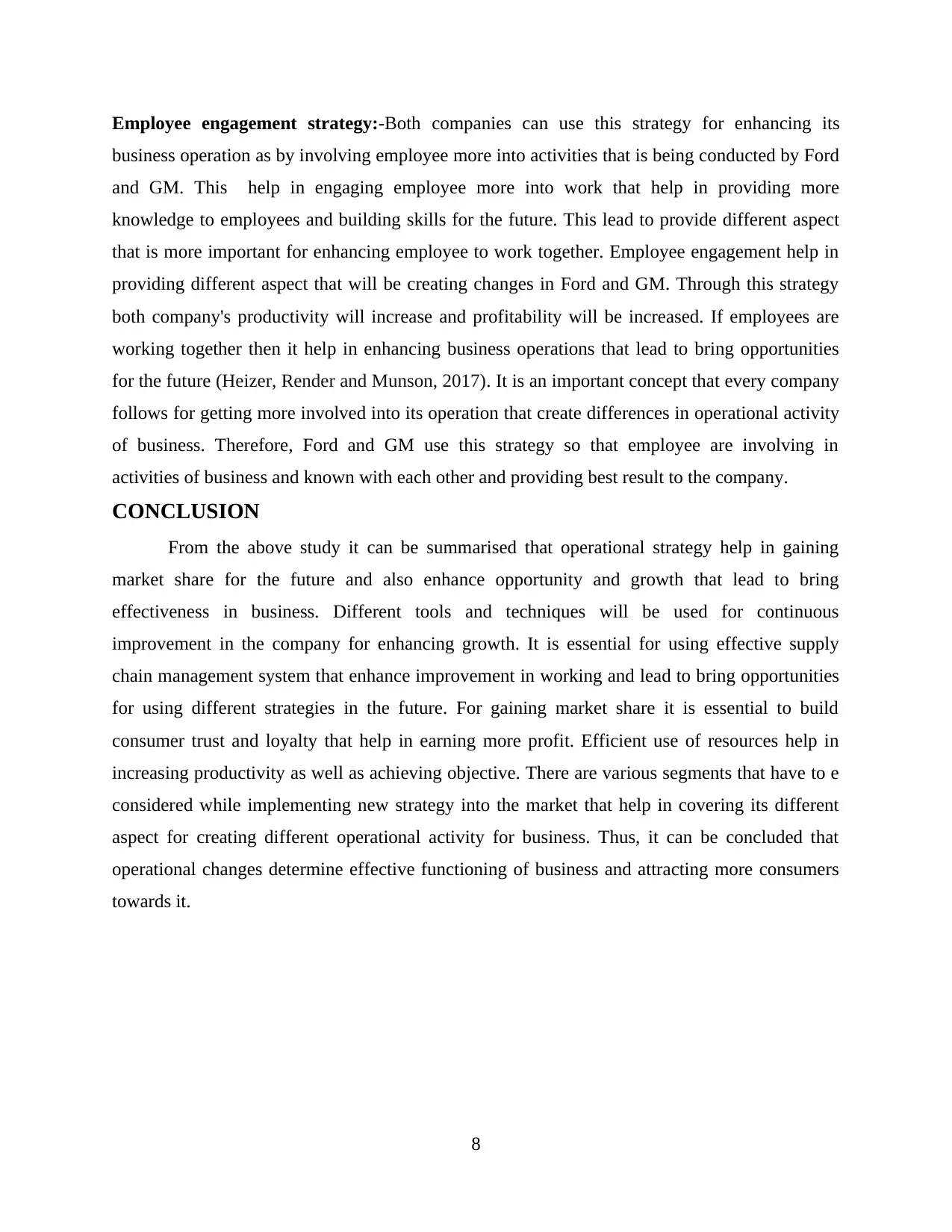
Employee engagement strategy:-Both companies can use this strategy for enhancing its
business operation as by involving employee more into activities that is being conducted by Ford
and GM. This help in engaging employee more into work that help in providing more
knowledge to employees and building skills for the future. This lead to provide different aspect
that is more important for enhancing employee to work together. Employee engagement help in
providing different aspect that will be creating changes in Ford and GM. Through this strategy
both company's productivity will increase and profitability will be increased. If employees are
working together then it help in enhancing business operations that lead to bring opportunities
for the future (Heizer, Render and Munson, 2017). It is an important concept that every company
follows for getting more involved into its operation that create differences in operational activity
of business. Therefore, Ford and GM use this strategy so that employee are involving in
activities of business and known with each other and providing best result to the company.
CONCLUSION
From the above study it can be summarised that operational strategy help in gaining
market share for the future and also enhance opportunity and growth that lead to bring
effectiveness in business. Different tools and techniques will be used for continuous
improvement in the company for enhancing growth. It is essential for using effective supply
chain management system that enhance improvement in working and lead to bring opportunities
for using different strategies in the future. For gaining market share it is essential to build
consumer trust and loyalty that help in earning more profit. Efficient use of resources help in
increasing productivity as well as achieving objective. There are various segments that have to e
considered while implementing new strategy into the market that help in covering its different
aspect for creating different operational activity for business. Thus, it can be concluded that
operational changes determine effective functioning of business and attracting more consumers
towards it.
8
business operation as by involving employee more into activities that is being conducted by Ford
and GM. This help in engaging employee more into work that help in providing more
knowledge to employees and building skills for the future. This lead to provide different aspect
that is more important for enhancing employee to work together. Employee engagement help in
providing different aspect that will be creating changes in Ford and GM. Through this strategy
both company's productivity will increase and profitability will be increased. If employees are
working together then it help in enhancing business operations that lead to bring opportunities
for the future (Heizer, Render and Munson, 2017). It is an important concept that every company
follows for getting more involved into its operation that create differences in operational activity
of business. Therefore, Ford and GM use this strategy so that employee are involving in
activities of business and known with each other and providing best result to the company.
CONCLUSION
From the above study it can be summarised that operational strategy help in gaining
market share for the future and also enhance opportunity and growth that lead to bring
effectiveness in business. Different tools and techniques will be used for continuous
improvement in the company for enhancing growth. It is essential for using effective supply
chain management system that enhance improvement in working and lead to bring opportunities
for using different strategies in the future. For gaining market share it is essential to build
consumer trust and loyalty that help in earning more profit. Efficient use of resources help in
increasing productivity as well as achieving objective. There are various segments that have to e
considered while implementing new strategy into the market that help in covering its different
aspect for creating different operational activity for business. Thus, it can be concluded that
operational changes determine effective functioning of business and attracting more consumers
towards it.
8
Paraphrase This Document
Need a fresh take? Get an instant paraphrase of this document with our AI Paraphraser
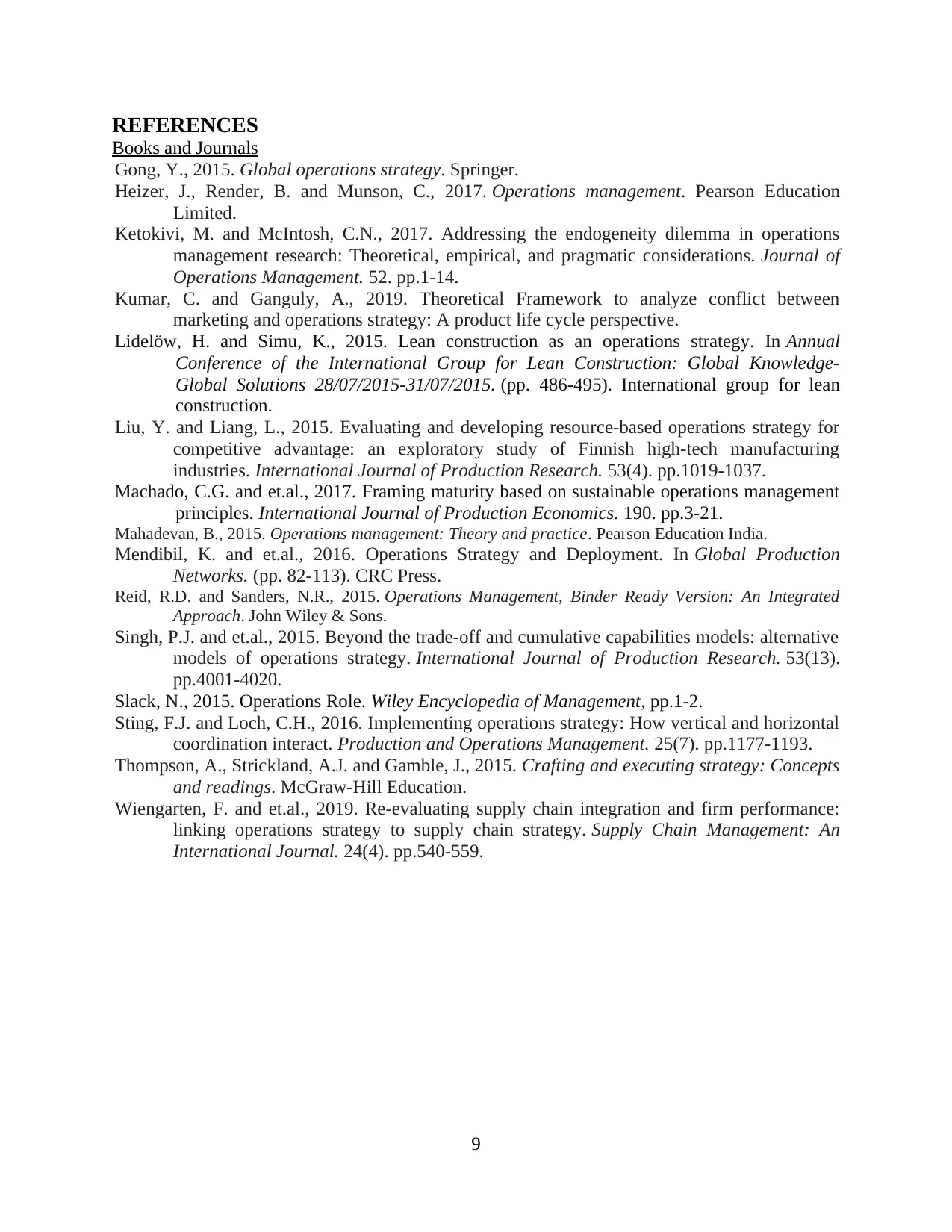
REFERENCES
Books and Journals
Gong, Y., 2015. Global operations strategy. Springer.
Heizer, J., Render, B. and Munson, C., 2017. Operations management. Pearson Education
Limited.
Ketokivi, M. and McIntosh, C.N., 2017. Addressing the endogeneity dilemma in operations
management research: Theoretical, empirical, and pragmatic considerations. Journal of
Operations Management. 52. pp.1-14.
Kumar, C. and Ganguly, A., 2019. Theoretical Framework to analyze conflict between
marketing and operations strategy: A product life cycle perspective.
Lidelöw, H. and Simu, K., 2015. Lean construction as an operations strategy. In Annual
Conference of the International Group for Lean Construction: Global Knowledge-
Global Solutions 28/07/2015-31/07/2015. (pp. 486-495). International group for lean
construction.
Liu, Y. and Liang, L., 2015. Evaluating and developing resource-based operations strategy for
competitive advantage: an exploratory study of Finnish high-tech manufacturing
industries. International Journal of Production Research. 53(4). pp.1019-1037.
Machado, C.G. and et.al., 2017. Framing maturity based on sustainable operations management
principles. International Journal of Production Economics. 190. pp.3-21.
Mahadevan, B., 2015. Operations management: Theory and practice. Pearson Education India.
Mendibil, K. and et.al., 2016. Operations Strategy and Deployment. In Global Production
Networks. (pp. 82-113). CRC Press.
Reid, R.D. and Sanders, N.R., 2015. Operations Management, Binder Ready Version: An Integrated
Approach. John Wiley & Sons.
Singh, P.J. and et.al., 2015. Beyond the trade-off and cumulative capabilities models: alternative
models of operations strategy. International Journal of Production Research. 53(13).
pp.4001-4020.
Slack, N., 2015. Operations Role. Wiley Encyclopedia of Management, pp.1-2.
Sting, F.J. and Loch, C.H., 2016. Implementing operations strategy: How vertical and horizontal
coordination interact. Production and Operations Management. 25(7). pp.1177-1193.
Thompson, A., Strickland, A.J. and Gamble, J., 2015. Crafting and executing strategy: Concepts
and readings. McGraw-Hill Education.
Wiengarten, F. and et.al., 2019. Re-evaluating supply chain integration and firm performance:
linking operations strategy to supply chain strategy. Supply Chain Management: An
International Journal. 24(4). pp.540-559.
9
Books and Journals
Gong, Y., 2015. Global operations strategy. Springer.
Heizer, J., Render, B. and Munson, C., 2017. Operations management. Pearson Education
Limited.
Ketokivi, M. and McIntosh, C.N., 2017. Addressing the endogeneity dilemma in operations
management research: Theoretical, empirical, and pragmatic considerations. Journal of
Operations Management. 52. pp.1-14.
Kumar, C. and Ganguly, A., 2019. Theoretical Framework to analyze conflict between
marketing and operations strategy: A product life cycle perspective.
Lidelöw, H. and Simu, K., 2015. Lean construction as an operations strategy. In Annual
Conference of the International Group for Lean Construction: Global Knowledge-
Global Solutions 28/07/2015-31/07/2015. (pp. 486-495). International group for lean
construction.
Liu, Y. and Liang, L., 2015. Evaluating and developing resource-based operations strategy for
competitive advantage: an exploratory study of Finnish high-tech manufacturing
industries. International Journal of Production Research. 53(4). pp.1019-1037.
Machado, C.G. and et.al., 2017. Framing maturity based on sustainable operations management
principles. International Journal of Production Economics. 190. pp.3-21.
Mahadevan, B., 2015. Operations management: Theory and practice. Pearson Education India.
Mendibil, K. and et.al., 2016. Operations Strategy and Deployment. In Global Production
Networks. (pp. 82-113). CRC Press.
Reid, R.D. and Sanders, N.R., 2015. Operations Management, Binder Ready Version: An Integrated
Approach. John Wiley & Sons.
Singh, P.J. and et.al., 2015. Beyond the trade-off and cumulative capabilities models: alternative
models of operations strategy. International Journal of Production Research. 53(13).
pp.4001-4020.
Slack, N., 2015. Operations Role. Wiley Encyclopedia of Management, pp.1-2.
Sting, F.J. and Loch, C.H., 2016. Implementing operations strategy: How vertical and horizontal
coordination interact. Production and Operations Management. 25(7). pp.1177-1193.
Thompson, A., Strickland, A.J. and Gamble, J., 2015. Crafting and executing strategy: Concepts
and readings. McGraw-Hill Education.
Wiengarten, F. and et.al., 2019. Re-evaluating supply chain integration and firm performance:
linking operations strategy to supply chain strategy. Supply Chain Management: An
International Journal. 24(4). pp.540-559.
9
1 out of 11
Related Documents
Your All-in-One AI-Powered Toolkit for Academic Success.
+13062052269
info@desklib.com
Available 24*7 on WhatsApp / Email
![[object Object]](/_next/static/media/star-bottom.7253800d.svg)
Unlock your academic potential
Copyright © 2020–2025 A2Z Services. All Rights Reserved. Developed and managed by ZUCOL.




